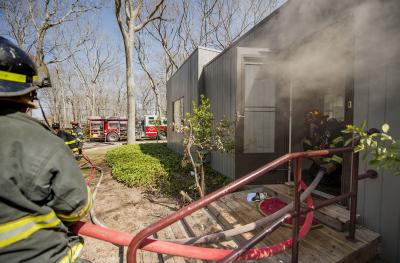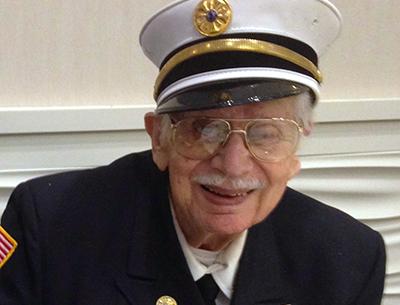Two Days and Two Lucky Escapes
Two Days and Two Lucky Escapes

A wheelchair-bound woman and her dog escaped a Water Mill house that was on fire Friday afternoon.
Bridgehampton Fire Chief Jeff White said the woman smelled and saw smoke coming up from the basement at 162 Noyac Path for at least a half-hour before leaving to get to help. The house phone was not working because of the fire. Once she reached the road, nearby workers called 911 at 2:21 p.m.
There was smoke coming up through the floors in the living room and kitchen when the chief arrived, and the fire had extended up an exterior wall and destroyed two of the floor joists. Chief White said the fire had been smoldering for some time. “Another 15 minutes and it really would have been burning,” he said.
John Rankin, a Southampton Town fire marshal who is investigating the fire’s cause, agreed with the chief that the woman was lucky she was able to get out of the house. Confined to a wheelchair and alone inside, she had a medical alert system, but it was not functioning, and her cellphone failed to pick up a signal.
Bridgehampton’s emergency medical services personnel examined her for smoke inhalation, but she was not transported to the hospital.
Though the major damage was confined to the basement, the house is not habitable as a result of the structural damage to the floors and an exterior wall, Mr. Rankin said.
The fire appeared to be electrical in nature, though the exact cause had not yet been pinpointed. Mr. Rankin said it did not appear to be suspicious but that insurance investigators would bring in experts to look into the electrical problem further. The wiring in the house, which was built in the 1990s, appeared to be in good shape, he said.
According to Southampton Town tax records, Kathleen Candy is the owner of the house, though Mr. Rankin said that was not the name of the woman in the wheelchair.
The Bridgehampton Fire Department got help from the Sag Harbor and Southampton Fire Departments. Though the fire was quickly knocked down, firefighters remained on scene for about an hour and a half. The East Hampton Fire Department stood by at the Bridgehampton Firehouse during the call.
A day earlier, in Sag Harbor, a firefighter fell while investigating a reported gas leak at the Sag Harbor Gym and was airlifted to the hospital. He suffered only a minor injury, however, and was home just a few hours later, Sag Harbor Fire Chief Thomas Gardella said.
Alex Smith, the captain in the Phoenix Hook and Ladder Company, had a contusion on his head. The 26-year-old was wearing his turnout gear and helmet. The chief said if he hadn’t been, “it could have been much more serious than what it was.”
Mr. Smith was inside the gym with Steven Miller, the second assistant chief, searching for the origin of the smell of gas that had been reported around 11:30 a.m. He was up on a ladder reaching into the drop ceiling with a gas meter when he either slipped or the ceiling gave way.
“He landed head-first onto the ground,” Chief Gardella said. A portion of the ceiling came down with him. He fell about eight feet.
The Sag Harbor Volunteer Ambulance Corps treated Mr. Smith, and he was airlifted to Stony Brook University Hospital, a level one trauma center, because of the height of the fall and the fact that he had hit his head.
Chief Gardella said the department then had to juggle two emergencies. “You have a potential gas leak and you have a firefighter that’s down. The first priority is to get the attention to the firefighter, to make sure he’s okay and get him out of the building,” he said. “It gets complicated.”
As it turned out, the gas leak report appeared to be unfounded. “Whatever they were smelling was not flammable,” he said. The gas meters showed no readings. Still, firefighters shut off the gas to the building and asked the gas company to respond to check the pressure.
Just after Mr. Smith was airlifted and the gym was cleared of any potentially dangerous fumes, the Sag Harbor Fire Department was called to stand by on Shelter Island while that department fought a house fire. Sag Harbor firefighters were needed for only about half an hour, Chief Gardella said.








